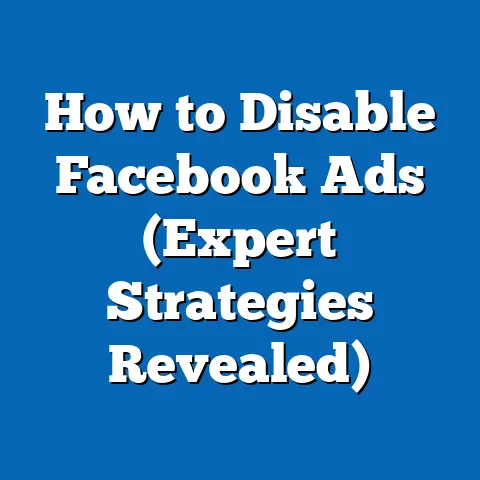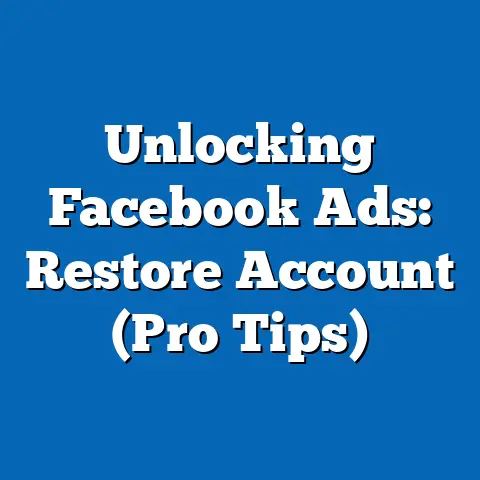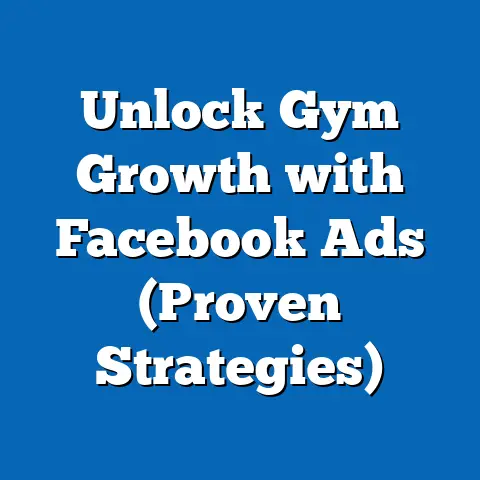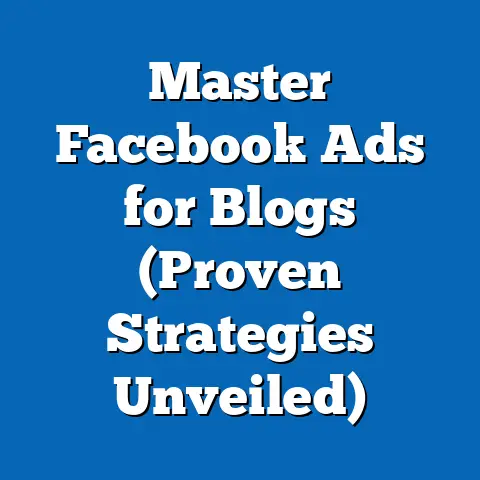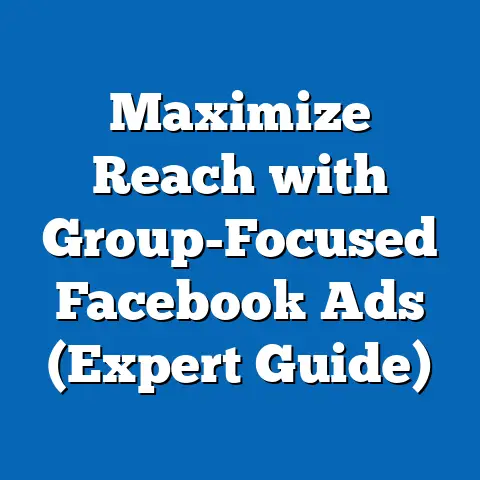Maximize Facebook Ad Revenue Share (Strategic Insights)
Maximize Facebook Ad Revenue Share: Strategic Insights for the Future
Imagine a future where every dollar you spend on Facebook ads returns multiple times over. A future where your ads resonate perfectly with your audience, driving sales and building brand loyalty. This isn’t just a pipe dream; it’s an achievable goal with the right strategies.
The digital advertising landscape is constantly shifting, with Facebook remaining a central player. With its massive user base and sophisticated targeting capabilities, Facebook offers incredible potential for businesses to connect with their customers. However, success on Facebook isn’t guaranteed. It requires a deep understanding of the platform, a keen eye on emerging trends, and a strategic approach to maximizing ad revenue share.
In this article, I’ll guide you through the intricacies of Facebook’s advertising ecosystem, explore the trends shaping its future, and provide actionable strategies to boost your ad revenue. We’ll also look at real-world examples of businesses that have cracked the code. Get ready to transform your Facebook advertising efforts and unlock the full potential of this powerful platform.
Understanding Facebook’s Advertising Ecosystem
Before we can talk about maximizing revenue share, it’s crucial to understand how Facebook’s advertising ecosystem works. It’s more than just throwing money at the platform and hoping for the best. It’s about understanding the rules of the game and playing them strategically.
Facebook’s algorithm is the gatekeeper, deciding which ads get seen and by whom. Understanding how it prioritizes content is essential. Factors like ad relevance, bid amount, and estimated action rates all play a role. Ads that are highly relevant to the user and have a strong track record of engagement are more likely to be shown.
Ad placements also matter significantly. Are you placing your ads in the news feed, in-stream videos, or the right-hand column? Each placement has its own strengths and weaknesses, and the best choice depends on your target audience and ad format. For instance, video ads often perform well in-stream, while image ads can be effective in the news feed.
Key metrics are your compass in this ecosystem. Let’s break them down:
- Cost-Per-Click (CPC): The amount you pay each time someone clicks on your ad. A lower CPC indicates that your ads are resonating with your audience and driving engagement at an efficient cost.
- Cost-Per-Impression (CPM): The amount you pay for every 1,000 impressions (times your ad is shown). CPM is useful for understanding the cost of reaching your target audience, even if they don’t click on your ad.
- Return on Ad Spend (ROAS): The revenue you generate for every dollar you spend on advertising. ROAS is the ultimate measure of success. A higher ROAS means your ads are generating more revenue.
Facebook provides powerful tools to help you navigate this ecosystem. Facebook Ads Manager is your central hub for creating, managing, and analyzing your campaigns. It allows you to target specific audiences, set budgets, and track performance. Audience Insights provides valuable data about your target audience, including their demographics, interests, and behaviors. This information can be used to create more targeted and effective ads.
Takeaway: Understanding Facebook’s advertising ecosystem is the foundation for maximizing your revenue share. By understanding the algorithm, optimizing ad placements, and tracking key metrics, you can create more effective campaigns that drive results.
Trends Shaping the Future of Facebook Ads
The world of Facebook advertising is constantly evolving, and it’s crucial to stay ahead of the curve. Several key trends are poised to shape the future of the platform, and understanding these trends is essential for maximizing your revenue share.
1. Increased Use of AI and Machine Learning
AI and machine learning are already transforming Facebook advertising, and their influence will only grow in the coming years. These technologies are being used to enhance targeting, personalize ads, and automate campaign management.
For example, Facebook’s “Advantage+” campaign budget feature uses AI to automatically allocate your budget across different ad sets, ensuring that your money is spent on the most effective ads. Similarly, dynamic creative optimization uses machine learning to automatically generate different versions of your ads, testing various combinations of headlines, images, and calls to action to find the best performing ones.
The increasing use of AI and machine learning means that advertisers can create more targeted, personalized, and effective ads, leading to higher engagement and revenue share.
2. Video Content Domination
Video has become the dominant form of content on social media, and Facebook is no exception. Video ads are more engaging than static images or text ads, and they have the potential to capture attention and drive action.
According to recent statistics, video ads have a higher click-through rate (CTR) and conversion rate than other ad formats. This is because video allows you to tell a story, showcase your product, and connect with your audience on an emotional level.
To capitalize on the video trend, advertisers need to create high-quality, engaging video ads that are optimized for mobile viewing. This means using short, attention-grabbing videos with clear messaging and a strong call to action.
3. Shift Towards E-commerce Integration
Facebook is increasingly integrating e-commerce features into its platform, making it easier for businesses to sell products directly to consumers. Shoppable ads, for example, allow users to purchase products directly from their Facebook feed.
This shift towards e-commerce integration is creating new opportunities for businesses to drive sales and increase revenue share. By creating shoppable ads and integrating their e-commerce platform with Facebook, businesses can create a seamless shopping experience for their customers.
4. Privacy Regulations Impact
Evolving privacy regulations, such as GDPR and CCPA, are having a significant impact on Facebook advertising. These regulations give users more control over their data and limit the ability of advertisers to target them with personalized ads.
To navigate these challenges, advertisers need to be transparent about their data collection practices and obtain consent from users before collecting their data. They also need to focus on creating ads that are relevant and engaging, even without personalized targeting.
Takeaway: Staying ahead of these trends is crucial for maximizing your Facebook ad revenue share. Embrace AI and machine learning, leverage video content, integrate e-commerce features, and adapt to evolving privacy regulations.
Strategic Approaches to Maximize Revenue Share
Now, let’s get into the nitty-gritty of how to actually maximize your revenue share on Facebook. This is where the rubber meets the road, and where you can start seeing real results.
1. Targeting the Right Audience
Targeting is the foundation of any successful Facebook advertising campaign. If you’re not targeting the right audience, your ads will be wasted on people who are not interested in your products or services.
Facebook offers a wide range of targeting options, allowing you to reach potential customers based on their demographics, interests, behaviors, and connections.
- Demographics: Target users based on age, gender, location, education, and other demographic factors.
- Interests: Target users based on their interests, such as hobbies, sports, music, and movies.
- Behaviors: Target users based on their online behavior, such as their purchase history, website visits, and app usage.
- Connections: Target users who are connected to your Facebook page or have interacted with your website.
Creating detailed audience personas can be incredibly helpful. Think about your ideal customer: What are their interests? What websites do they visit? What are their pain points?
2. Creative Ad Formats
Facebook offers a variety of ad formats, each with its own strengths and weaknesses. Using the right ad format can make a big difference in the effectiveness of your campaign.
- Image Ads: Simple and effective for showcasing products or services.
- Video Ads: Engaging and immersive, ideal for telling a story or demonstrating a product.
- Carousel Ads: Allow users to scroll through multiple images or videos in a single ad.
- Dynamic Ads: Automatically show products to users who have previously viewed them on your website.
- Collection Ads: Showcase a collection of products in a visually appealing format.
Experiment with different ad formats to see what works best for your target audience and your advertising goals.
I’ve personally found carousel ads to be particularly effective for showcasing multiple products in a single ad. They allow users to browse through different options and find the product that best meets their needs.
3. A/B Testing and Optimization
A/B testing is the process of testing different versions of your ads to see which one performs best. This involves creating two or more versions of your ad, each with a different headline, image, or call to action, and then running them simultaneously to see which one generates the most clicks, conversions, or other desired outcomes.
A/B testing is essential for optimizing your Facebook advertising campaigns and maximizing your revenue share. By testing different ad components, you can identify the most effective combinations and improve the performance of your ads over time.
4. Retargeting Strategies
Retargeting is the process of showing ads to users who have previously interacted with your website or Facebook page. This can be an incredibly effective way to drive conversions and increase revenue share.
For example, you can retarget users who have visited your product pages but haven’t made a purchase. By showing them ads for the products they were interested in, you can remind them of your offerings and encourage them to complete their purchase.
5. Ad Budget Allocation
Smart budget allocation is crucial for maximizing your reach and efficiency. Don’t just set a budget and forget about it. Monitor your campaigns closely and adjust your budget based on performance analytics.
If you see that a particular ad set is performing well, consider increasing its budget to reach more people. Conversely, if an ad set is underperforming, consider decreasing its budget or pausing it altogether.
Takeaway: Maximizing your Facebook ad revenue share requires a strategic approach that encompasses audience targeting, creative ad formats, A/B testing, retargeting, and budget allocation.
Case Studies of Success
Let’s look at some real-world examples of businesses that have successfully maximized their Facebook ad revenue share.
Case Study 1: Fashion Retailer
A fashion retailer used Facebook ads to drive sales of its new clothing line. They targeted women aged 25-45 with interests in fashion and style. They used carousel ads to showcase different outfits and ran A/B tests to optimize their ad copy and images. They also used retargeting to show ads to users who had visited their website but hadn’t made a purchase.
As a result, they saw a 30% increase in sales and a significant boost in their ROAS.
Case Study 2: Local Restaurant
A local restaurant used Facebook ads to promote its new menu items and drive reservations. They targeted people within a 5-mile radius of their restaurant with interests in food and dining. They used video ads to showcase their dishes and ran A/B tests to optimize their targeting and ad copy. They also used retargeting to show ads to users who had visited their website or liked their Facebook page.
They saw a 20% increase in reservations and a significant boost in their revenue.
Takeaway: These case studies demonstrate that with the right strategies, businesses of all sizes can successfully maximize their Facebook ad revenue share.
Conclusion
As Facebook continues to evolve, advertisers must stay ahead of the curve by embracing new strategies and technologies. By understanding the platform’s ecosystem, staying abreast of emerging trends, and implementing strategic approaches, you can unlock the full potential of Facebook advertising and maximize your revenue share.
Think proactively about your own Facebook advertising efforts. What strategies can you implement to improve your targeting, ad formats, A/B testing, retargeting, and budget allocation?
The future of Facebook advertising is bright, and with the right approach, you can be a part of it.

